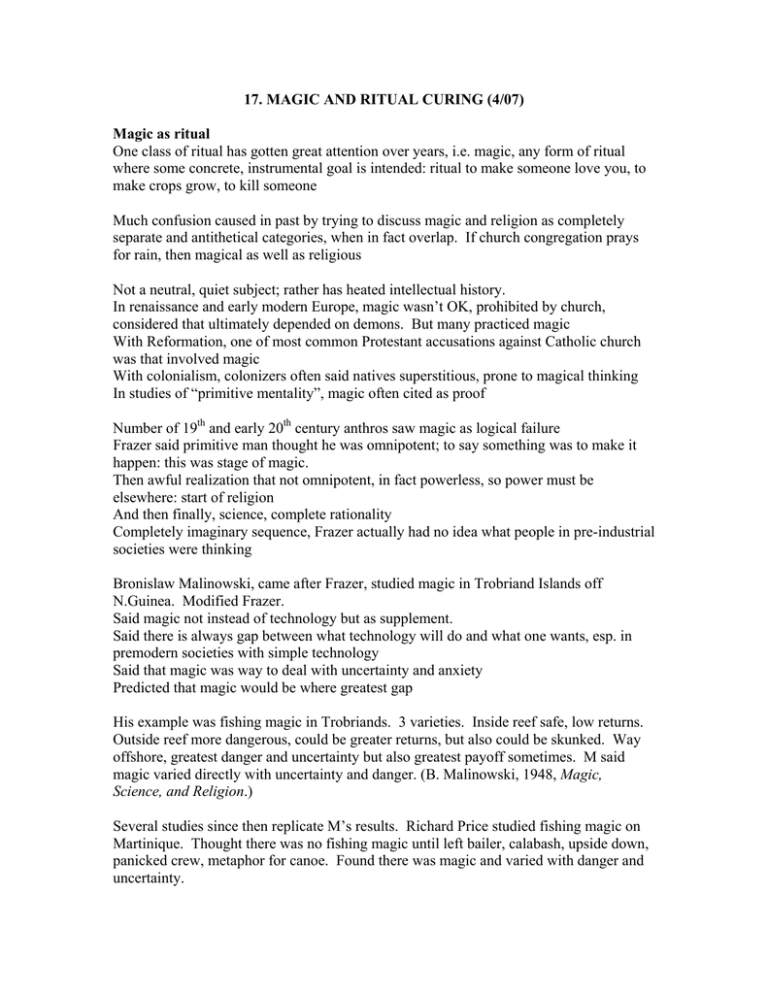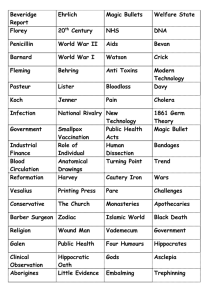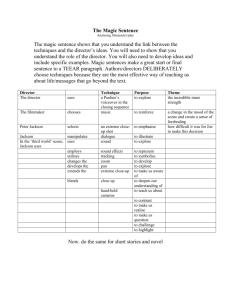17. MAGIC AND RITUAL CURING (4/07) Magic as ritual
advertisement

17. MAGIC AND RITUAL CURING (4/07) Magic as ritual One class of ritual has gotten great attention over years, i.e. magic, any form of ritual where some concrete, instrumental goal is intended: ritual to make someone love you, to make crops grow, to kill someone Much confusion caused in past by trying to discuss magic and religion as completely separate and antithetical categories, when in fact overlap. If church congregation prays for rain, then magical as well as religious Not a neutral, quiet subject; rather has heated intellectual history. In renaissance and early modern Europe, magic wasn’t OK, prohibited by church, considered that ultimately depended on demons. But many practiced magic With Reformation, one of most common Protestant accusations against Catholic church was that involved magic With colonialism, colonizers often said natives superstitious, prone to magical thinking In studies of “primitive mentality”, magic often cited as proof Number of 19th and early 20th century anthros saw magic as logical failure Frazer said primitive man thought he was omnipotent; to say something was to make it happen: this was stage of magic. Then awful realization that not omnipotent, in fact powerless, so power must be elsewhere: start of religion And then finally, science, complete rationality Completely imaginary sequence, Frazer actually had no idea what people in pre-industrial societies were thinking Bronislaw Malinowski, came after Frazer, studied magic in Trobriand Islands off N.Guinea. Modified Frazer. Said magic not instead of technology but as supplement. Said there is always gap between what technology will do and what one wants, esp. in premodern societies with simple technology Said that magic was way to deal with uncertainty and anxiety Predicted that magic would be where greatest gap His example was fishing magic in Trobriands. 3 varieties. Inside reef safe, low returns. Outside reef more dangerous, could be greater returns, but also could be skunked. Way offshore, greatest danger and uncertainty but also greatest payoff sometimes. M said magic varied directly with uncertainty and danger. (B. Malinowski, 1948, Magic, Science, and Religion.) Several studies since then replicate M’s results. Richard Price studied fishing magic on Martinique. Thought there was no fishing magic until left bailer, calabash, upside down, panicked crew, metaphor for canoe. Found there was magic and varied with danger and uncertainty. George Gmelch, studied personal magic in baseball. Nomar Garciaparra the most extreme example but such personal magic pervasive in baseball. Found that most magic for pitching and hitting, most uncertainty, also where most likely to get into extended good or bad runs of luck. Base-running and fielding more predictable, less magic. (Gmelch, “Baseball Magic,” Human Nature 1, 1978) Vogt & Hyman, anthro and psychologist, studied dowsing or water-witching in U.S., magical searching for water. Found strong statistical correlation with counties where finding water most uncertain, not where find water every time or almost never. (Water Witching USA, 1953). But not universally accepted. Pointed out that even in Trobriands, much more magic for gardening, yet gardening not uncertain at all. However, estimates of reliability of agriculture often wrong if only see short run---droughts come once in great while, not regularly. More important, clear that exchanges of produce very important in Trobriand kinship and politics, could be argued that great uncertainty in uses of agriculture. But doubt that M’s theory universally applicable. Kuna avid fishermen, lots of uncertainty, yet no fishing magic at all. Hunting minor part of diet, yet hunters often use magic. Douglas, who we read on animals, went even further, said mistake to think magic really for instrumental ends. Rather it is symbolizing desires and intentions. Example from Dinka of Sudan, who when late getting home, tie up tuft of grass, to help them get home on time. (Purity and Danger 1966, pp. 58-72). Also societies that have rain magic just when dry season ending. Similar point made by Tambiah (“Form and Meaning of Magical Acts,” in Culture, Thought, and Social Action, 1985). D.’s point is very important. When ritual has instrumental end, shouldn’t jump to assumption that nothing else important. Important to treat like any other ritual. But consensus that she overstates case. My experience and many other anthros that in many cases people care a lot about curing sick, etc. D. doesn’t really know what in head of man tying grass, just assuming. But certainly much still up in air. M’s theory in particular should probably be treated as partial. I don’t think that explains everything, but does seem to account in rough way for distribution of magic in certain domains. Q. Can you think of areas of anxiety or uncertainty in your life at MIT or in American society where magic proliferates? May not always be called magic. Exams, lots of personal magic. Gambling, whether lottery or at casino. Personal appearance, looks. Cosmetics promise tremendous amount, only small part true. Curing Illness and health certainly fit Malinowski’s paradigm: area of great anxiety, where wide gap between what want and what can do History of medicine suggests that physicians could do relatively little until recently Most of the great advances of modern medicine are recent, oldest couple hundred years old Many claims have been made for what now called “alternative” medicine, for curing systems of pre-industrial cultures. Also, in recent years, search for herbal medicines known to non-western societies. Great hope of finding new medicines within those known to non-western curers. Certainly there are such medicines: quinine, from bark of cinchona tree, known to indigenous Peruvians before discovered by West Native South and Central Americans had discovered wide variety of hallucinogens, used in ritual, must have experimented a lot No doubt many ways that traditional systems efficacious in physical way But dangers in such claims. Dangers in our romanticizing. Image of “tribal wisdom”. Dangers in defending against ethnocentrism. Also dangers because the issue of curing is politically salient in many cases: whether someone uses traditional therapies or modern medicine highly politicized issue Also very little real info on efficacy of various remedies---lot of what we have is just assertion Often assumed that people living in simple societies avoided all sorts of bad conditions of modern world, essentially much healthier than we in our polluted world But recent archaeological studies have found widespread chronic conditions, short lives Romanticization is as big a danger as ethnocentric scorn Safe to say that there is gap between what desired and what achieved in almost all medical systems. And it turns out that one of the ways gap is spanned is by persuasion thru ritual Effects of mind on body A lot of different kinds of evidence for effects of mind on body. Most famous perhaps is negative effect, called "voodoo death" Most famously studied by physiologist at Harvard (already mentioned previous lecture), Walter Cannon (1957, “Voodoo” Death. Psychsomatic Medicine 19(3): 182-190. Sternberg, 2002, “Walter B. Cannon and ’Voodoo’ Death: A Perspective from 60 years on.” Am. J. of Public Health 92:1564-1566). Still controversial, because built on case histories, many unreliable. Suggested that in many cases could have been poisoning. But many think real, that people in various cultures can be convinced to die if sure that being bewitched Cannon said death caused by shock resulting from continuous outpouring of adrenalin, heart beat faster and faster. Other mechanisms since been suggested. One relevant study, would be impossible today Put rats in tank, had to keep swimming until drowned. Often as much as 60 hours, 1 ½ days. Incredibly tenacious animals. But if held in hand first, or if cut whiskers, then gave up very fast, demoralized. On other hand, if did several times, they got accustomed, then no effect. Another tack, case: WWII field hospitals, for schistomiasis. One with low morale, lots of info on dangers of disease; other very upbeat, had much higher cure rate. Opposite observed in hospital, patients giving up, dying Though recent study mentioned in NYT disagreed, implication that we moralize dying, ready to see as partly effort of will by patient one way or other Another: actuarial tables, insurance statistics. One on "life shocks" and effect on heart attacks etc. Rated shocks: worst death of spouse, then divorce, then death of parent, then loss of job. Other direction, large statistical study by psychologist at Penn some years ago. Many variables, to see whether any correlated statistically with surviving. Only one significant had been put in almost by accident, whether had pet. Since then many other studies. To extent that today have digs esp. trained to visit nursing homes, give attention and love. Drop in blood pressure when stroke. May be to do with unconditional affection by animal. Many other studies, e.g. linking certain personality types with illness. Relaxation. Prayer. Q. Why does such talk upset Sontag? Because can end up blaming the victim. In example she looked at, said cancer patients sexually repressed. Where not blaming victim, often seems to be asserting more control over our bodies and health than we actually have. Many of claims for effect of mind on body hotly contested. E.g. most famous effect is "placebo effect" dummy medicines encouraging recovery. Recent study cast doubt. So question is open, but in balance, suggestion that room for some curing thru persuasion. How does ritual curing work? Turner’s answer. Victor Turner again. Classic case history. Q. What is mechanism causing patient’s illness? Tooth of dead hunter, intrusive object, ultimately is ancestor. Also witchcraft. Notice that diagnosis implies a cure. Idiom by which illness is understood: If illness caused by soul loss, then get soul back. If illness caused by imbalance of humors or hot/cold or yin/yang, then get back in balance. If caused by intrusive object, then get it out. Shamans in many societies masters at creating illusion of pulling out. In contemporary world grand masters are Philippine “psychic surgeons” Q. How does patient’s condition connect with his personal problems? problems with marriage, with residence, connections with kin, general ineffectiveness. Also unpopular. Q. How connected with wider social problems? factionalism in village and kin group. Q. So apart from particulars of cure, what model of ritual curing does T offer? What are the essentials? -personal tied up with social. We separate but they don’t. -have to purge hostility, resolve conflicted relations. -mechanism is a masterful social drama, in which everyone drawn in. Of course depends on his problem being malaise rather than organic illness. Hard to see how this could cure worms or TB. What about Esalen example discussed in reading by Holloman? Esalen was very big several decades ago, notorious because participants sometimes nude. I noticed change in author, a friend, before I read article, so I ready to be convinced. But again, this is a personal, psychological or social change, not curing organic illness. Q. So what is the mechanism in this case? The retreat like a rite of passage, with separation, liminality, reintegration. What do to old identity? No names, no status differences. How do they work you over to help effect change? massage, Rolfing, nudity, touch, meditation Comunitas in way Turner predicted How does ritual persuasion work? Lévi-Strauss answers One of most famous cases, not in our readings, from L-S, and happens to be from Kuna L-S never worked with them. Got from publication of a curing chant. Collected by indigenous anthro, Guillermo Hayans, who mailed to Sweden, where published. Muu igala “grandmother’s way”, for difficult, protracted childbirth L-S had just text and some ethnographic background on Kuna Made sense of it thru close reading Chanter sends army of shaman spirits to spirit world Describes spiritual journey up surreal, bloody rivers to home of spirit named Muu, who has the soul of the child The shamans get soul away from Muu and bring it back then baby can be born L-S compared the process to psychoanalysis In therapy, the therapist and patient work for long time to understand history of patient’s hang-ups, then cured thru understanding L-S says doesn’t matter if the story the two create together is true, they building a narrative together which works because persuades patient Says Kuna curing like that: chanter presents story, patient identifies her trials with story, and then resolves problem giving birth Most generally, curing by presenting persuasive symbols for patient to identify with In his close reading of text, L-S said the bloody rivers etc. are really a metaphor for the womb: the good spirits are really traveling up birth canal to the womb to free the child so it can be born Ingenious interpretation Various details in text to corroborate interpretation: mentioned thing called nusupane: L-S consulted Kuna dictionaries, said nusu meant worm and could mean penis; pane also could mean penis. So this was really penis. Then friend of mine, Mac Chapin, did more thoroughly study of Kuna curing than had been done before. In some ways L-S mostly right. Muu, which means both grandmother and midwife, is spirit in realm above where fetuses formed She sends them to earth when ready But sometimes can’t bear to give them up, must force her Chanters told Chapin that yes, was a metaphor for woman’s reproductive system, but also really was journey thru spirit world Some of details wrong: nusupane nothing to do with penises, rather ‘worm that moves back and forth’, i.e. butterfly. The problem was that the patient not following along with chant. Chanter always at least outside birth hut and often in another place altogether. Even when chanting close by, using secret spirit language of chants. Most non-chanters don’t know, or don’t know much also unlikely that woman in great pain is listening closely to chant So cure cannot work as L-S said More than that, we have no evidence that it ever did cure. L-S worked purely from text. He had no case histories at all, just presumption that it cured. His analysis very influential, cited over and over, but few people face fact that L-S had no idea at all whether or not chant was efficacious Seems very likely that the chant helps woman, probably does so by giving her confidence that something is being done, which helps her wait it out. The difficult birth will eventually work itself out, and what is needed is something to help her with pain and torment in the meanwhile. L-S’s model assumes that somehow the woman’s body is the problem, is holding the baby back, just needs to let go, very unlikely (“The Effectiveness of Symbols,” in Structural Anthropology, 1963, pp. 186-205; Mac Chapin, “Muu Ikala, Kuna Birth Ceremony” in Ritual and Symbol in Native Central America, P. Young & J.Howe, eds., 1976, University of Oregon Anthropological Papers 9, pp. 57-66.) Paradox that L-S incorrect about birth ritual, but his model may still be useable in many cases. Persuasive set of symbols that move us through, get us to believe in cure. I found true even among Kuna themselves. They have a crisis ritual in which exorcize oppressing spirits Epidemic, or drowning, or other traumatic accidents Then see spirits, talk to them World heated up Seer consults spirits, finds out they are agitated: sometimes because men have accidentally chopped down tree to which spirits have fastened invisible clothesline. So prepare for mass exorcism. Close village for 8 days, patrol boundaries. No one can have sex. Carve dozens of balsawood figures, represent good spirits. also boxes of such spirits, small carvings, from every house Plus lots of medicines burnt in braziers And everyone smokes. get all the cigarettes and pipe tobacco, every available brand Every night village assembles in evening, smoke for several hours while chanter chants If someone farts, they have to smoke huge pipe very fast I couldn’t get anyone to explain for long time Finally found out that smoke is being converted spiritually into cane beer for spirits Good spirits are brewing it up using tobacco smoke On 8th night good spirits throw party, get evil spirits drunk, then drop a net on them Banish most of them away, though a few may bargain with seer and chanter, get to stay if behave well Everyone participating knows the story, and the seer reports on developments And according to testimony, really does work. Epidemic may be mostly over; if recurs, then another exorcism But real effect is to re-establish morale of community. Very similar to Turner’s case. Like Holloman’s case, may involve physically working over participants---effects of all that smoking. People say they know it works because people no longer have encounters with spirits. At same time does other things, ritual multipurpose, multiple layers. Kuna have been in coastal and island environment only since mid-19th century; they say they had many exorcisms as moved into new environment, exorcise all the spirits that lived there. Also seems to be way of making claim to territory---do exorcism for village and for lands around it claimed by village. Seems to have been way of staking claim, also way of establishing and integrating new community in the new environment. Here L-S’s model works very well. As people sit there smoking, only some of them understand all the ritual language of the chant, but everyone knows the basic story, stages of what happening with the spirits.




